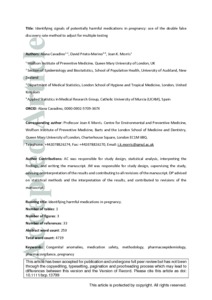Cavadino, A; Prieto-Merino, D; Morris, JK
(2019)
Identifying signals of potentially harmful medications in pregnancy: use of the double false discovery rate method to adjust for multiple testing.
Br J Clin Pharmacol, 85 (2).
pp. 356-365.
ISSN 1365-2125
https://doi.org/10.1111/bcp.13799
SGUL Authors: Morris, Joan Katherine
![[img]](https://openaccess.sgul.ac.uk/111472/1.hassmallThumbnailVersion/Cavadino_et_al-2018-Identifying_signals_harmful_medications_pregnancy-Accepted.pdf)  Preview |
|
PDF
Accepted Version
Available under License ["licenses_description_publisher" not defined].
Download (1MB)
| Preview
|
Abstract
AIMS: Surveillance of medication use in pregnancy is essential to identify associations between first trimester medications and congenital anomalies (CAs). Medications in the same Anatomical Therapeutic Chemical classes may have similar effects. We aimed to use this information to improve the detection of potential teratogens in CA surveillance data. METHODS: Data on 15 058 malformed fetuses with first trimester medication exposures from 1995-2011 were available from EUROmediCAT, a network of European CA registries. For each medication-CA combination, the proportion of the CA in fetuses with the medication was compared to the proportion of the CA in all other fetuses in the dataset. The Australian classification system was used to identify high-risk medications in order to compare two methods of controlling the false discovery rate (FDR): a single FDR applied across all combinations, and a double FDR incorporating groupings of medications. RESULTS: There were 28 765 potential combinations (523 medications × 55 CAs) for analysis. An FDR cut-off of 50% resulted in a reasonable effective workload, for which single FDR gave rise to eight medication signals (three high-risk medications) and double FDR 50% identified 16 signals (six high-risk). Over a range of FDR cut-offs, double FDR identified more high-risk medications as signals, for comparable effective workloads. CONCLUSIONS: The double FDR method appears to improve the detection of potential teratogens in comparison to the single FDR, while maintaining a low risk of false positives. Use of double FDR is recommended in routine signal detection analyses of CA data.
| Item Type: |
Article
|
| Additional Information: |
This is the peer reviewed version of the following article: Cavadino, A., Prieto‐Merino, D., and Morris, J. K. ( 2019) Identifying signals of potentially harmful medications in pregnancy: use of the double false discovery rate method to adjust for multiple testing. Br J Clin Pharmacol, 85: 356– 365, which has been published in final form at https://doi.org/10.1111/bcp.13799. This article may be used for non-commercial purposes in accordance with Wiley Terms and Conditions for Use of Self-Archived Versions. |
| Keywords: |
congenital anomalies, medication safety, methodology, pharmacoepidemiology, pharmacovigilance, pregnancy, congenital anomalies, medication safety, methodology, pharmacoepidemiology, pharmacovigilance, pregnancy, Pharmacology & Pharmacy, 1115 Pharmacology and Pharmaceutical Sciences |
| SGUL Research Institute / Research Centre: |
Academic Structure > Population Health Research Institute (INPH) |
| Journal or Publication Title: |
Br J Clin Pharmacol |
| ISSN: |
1365-2125 |
| Language: |
eng |
| Dates: |
| Date | Event |
|---|
| 20 January 2019 | Published | | 26 November 2018 | Published Online | | 11 October 2018 | Accepted |
|
| Publisher License: |
Publisher's own licence |
| Projects: |
|
| PubMed ID: |
30350871 |
| Web of Science ID: |
WOS:000456178500005 |
 |
Go to PubMed abstract |
| URI: |
https://openaccess.sgul.ac.uk/id/eprint/111472 |
| Publisher's version: |
https://doi.org/10.1111/bcp.13799 |
Statistics
Item downloaded times since 11 Dec 2019.
Actions (login required)
 |
Edit Item |



